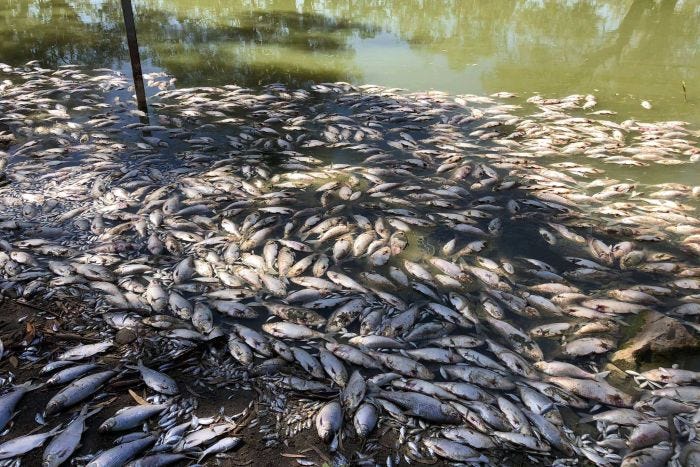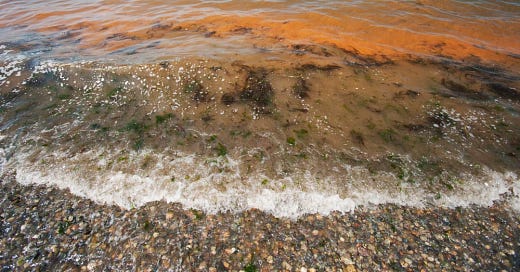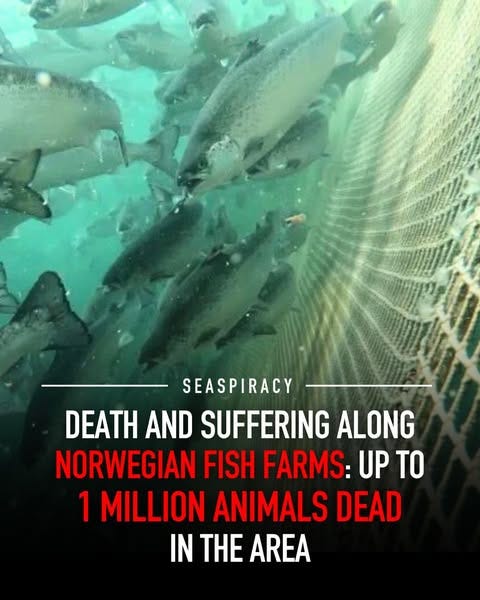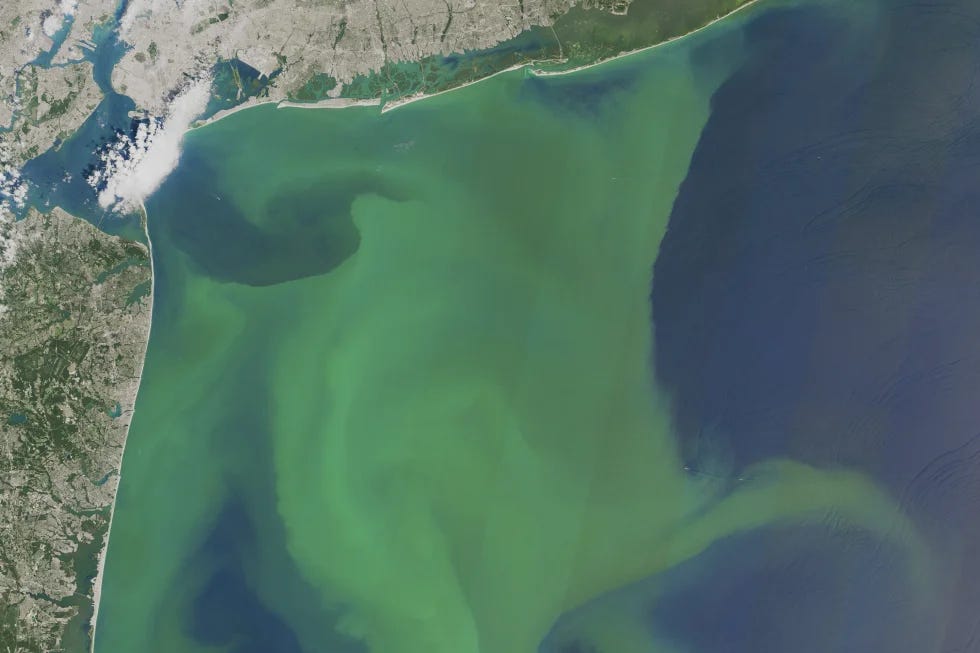Green, red, brown: The ocean’s toxic palette before collapse
Harmful algal blooms are spreading worldwide, and the ocean can’t take it anymore.
The ocean is not just getting warmer. It’s turning green, red, brown. Opaque.
And then it dies.
We’ve seen it before. You’ve read it in a previous Sea Stories about Australia’s southern coast current situation. Once home to seadragons and seals, it became a kill zone during one of the worst algal blooms in modern history. Now, from Norway to Chile to the Gulf of Mexico, the same story repeats. Different waters. Same sickness.
Mass fish deaths. Suffocating shores. Collapsing food webs.
The world calls them "harmful algal blooms."
We call them what they are:
A symptom.
A warning.
A sign of collapse.
Scroll down to read the full story.
When balance breaks: The rise of harmful algal blooms
There was a time when the sea pulsed with balance. Phytoplankton drifted in synchrony with the tides, feeding the smallest life, which fed the largest. Fish migrated, birds nested, reefs shimmered.
Now we see green tides strangling coral reefs. Brown foam slicking beaches. Red blooms. These aren't rare anymore. They're the new normal.
These are harmful algal blooms (HABs) — explosions of microscopic organisms that deplete oxygen, block sunlight, and often release neurotoxins. And they are sweeping the world.
Why now? The science of harmful algal blooms.
Algal blooms are natural phenomena, but experts agree the 2020s are seeing them grow more extreme. Blooms like those happening in Australia and Norway occur when tiny phytoplankton find perfect storm conditions: plenty of light and nutrients, and waters warm and still. Scientists point to several key factors fueling the recent outbreaks:
Warming seas and marine heatwaves: Global warming has supercharged the oceans. Many HAB species grow fastest in unusually warm water. South Australia’s bloom, for instance, coincided with a marine heatwave 2.5°C above normal. The climate crisis is expected to increase the severity and frequency of blooms worldwide.
Nutrient runoff – fertilizers, sewage, farm waste: Algae feast on nitrogen and phosphorus. Excess nutrients from rivers, farms and even fish farms can fertilize coastal waters. Agricultural runoff and river floods have long been linked to blooms in lakes and estuaries. Fish farm waste plays a huge role too, emissions of nutrients from fish farms may prolong a bloom’s ability to do harm. In short, human pollution acts like algae fertilizer.
Dense blooms clog fish gills and starve them of oxygen. And farms act as death traps.
Unlike wild fish that can (sometimes) flee, farmed fish are penned in, forced to breathe the same toxic water as algae multiply. In Norway, as fjords turned green, salmon began bleeding from their gills, a clear sign of exposure to Chrysochromulina toxins. More than eight million fish suffocated during that event a few years ago, and the same story is repeating itself with over a million deaths in the last week. Not because the blooms were inescapable, but because the fish were never free to escape.
This is the inherent cruelty of industrial aquaculture: not just confining sentient beings in crowded, unnatural pens, but subjecting them to entirely preventable suffering. Fish farms amplify ecological breakdown, pollute the ocean, and turn localized blooms into large-scale marine disasters.
The bigger picture: Ocean collapse and climate crisis
These catastrophic blooms aren’t isolated events. They are part of a larger, systemic failure, a collapse fueled by industrial activity, political inaction, and climate breakdown.
We’re not just seeing algae. We’re seeing the ocean lose its ability to regulate life.
Warming waters dissolve less oxygen. Runoff feeds eutrophication1. Coral reefs bleach. Fish populations dwindle. Algal blooms are simply the latest and most visible symptom of an ocean being pushed beyond its limits.
In Norway, the salmon farming industry continues to operate in fragile fjords, despite repeated die-offs. In South Australia, the bloom killed not only wild fish, but rays, sharks, crabs, octopuses... Whole ecosystems suffocated not gradually, but suddenly, and in full view of coastal communities.
And these are not even the worst-case scenarios.
Scientists warn that with every additional degree of warming, more of the ocean will cross into bloom-prone conditions.
As the EPA, NOAA, and OceanWise have reported, harmful algal blooms have surged by over 50% in recent decades, largely driven by climate change and nutrient pollution. This is no longer just a scientific warning. It’s an unfolding reality.

From pollution to policy failure: Who is to blame?
Let’s be clear: this didn’t just happen.
Governments, corporations, and industrial lobbies have spent years ignoring the warnings.
Fertilizer giants, industrial livestock operations, and aquaculture conglomerates continue to dump waste into watersheds without accountability. Climate targets are missed. Fish farms expand. And coastal communities are left to bury the bodies of fish and ecosystems.
What happens when the sea can no longer clean itself?
We often treat the ocean as a limitless sink — for heat, for carbon, for waste.
But blooms remind us: even the ocean has a threshold.
When we overload it with pollution, cage millions of fish, and raise global temperatures beyond safe levels, it stops filtering. It stops recovering. It starts breaking. And when it breaks, it breaks fast.
We’ve seen this before in the Gulf of Mexico, in the Baltic Sea, in the Mediterranean. And now, we’re seeing it again.
What you can do
Reject industrial aquaculture. Don’t buy the “sustainable” farmed fish lie. Fish farms pollute oceans, spread disease, and magnify bloom disasters.
Support land and ocean reform. Push for nutrient runoff regulations, wetland protections, and coastal buffer zones.
Call out climate inaction. Harmful blooms are intensified by climate breakdown. Net-zero pledges mean nothing without enforcement and transparency.
Defend ocean justice. Amplify the voices of Indigenous and coastal communities demanding clean water.
The ocean has reached a tipping point.
We either change course now, or witness mass die-offs become the new normal.
Stay loud, stay informed, stay active.
Eutrophication is the excessive enrichment of a water body with nutrients, primarily nitrogen and phosphorus. This leads to an increase in plant and algae growth, potentially resulting in algal blooms, oxygen depletion, and other negative impacts on aquatic ecosystems.








